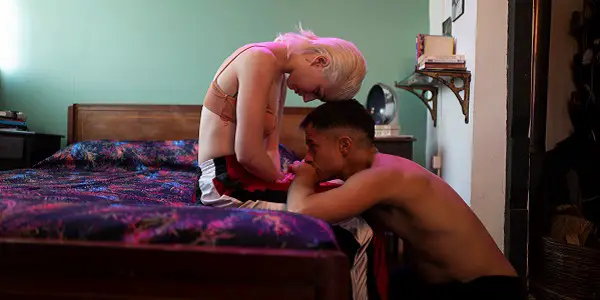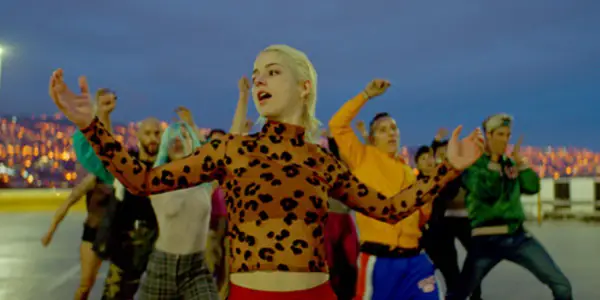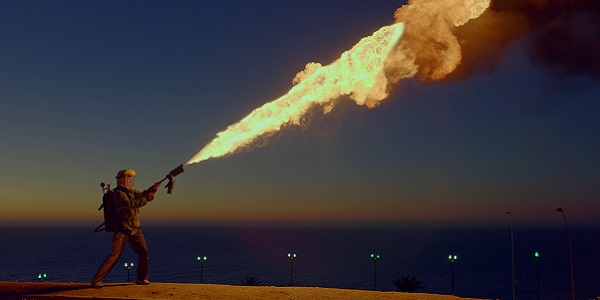EMA: The Body Electric

Lee Jutton has directed short films starring a killer toaster,…
Before Pablo Larraín’s much-anticipated new film Spencer, starring Kristen Stewart as Princess Diana, hits festivals later this year, we have Ema, the dance-fueled drama that made a splash at the Venice Film Festival back in 2019. From the very first evocative shot — a streetlight in flames on a dark street as a mysterious figure watches it burn — Ema makes an impact that is hard to ignore, even as the film’s flaws grow more and more obvious throughout.
Marriage Story
Ema (Mariana Di Girólamo) is a dancer in an experimental company led by her husband, Gastón (Gael García Bernal), a man of — how shall we say it? — extreme artistic temperament who is twelve years her senior. Their tempestuous relationship is being smashed on the rocks as the film begins, and the reasons for their endless verbal sparring are soon revealed. The two of them had adopted a young boy named Polo (Cristián Suárez), a student at the school where Ema teaches dance. At that awkward in-between age where he’s no longer a baby but not quite a teenager, Polo is a destructive child who gets into his fair share of trouble, culminating in setting a fire that brutally scars the face of Ema’s sister.
Confused, hurt, and not sure what else to do, Ema returns her son to the orphanage. It’s an action she clearly regrets, but that the sharp-tongued social worker Marcela (Catalina Saavedra) believes is the best thing for all involved: “Just stick to your f*cking dancing. Buy a doll, dress it up. Because what you want isn’t a child.” Gastón blames Ema’s inability to appropriately mother a child who he claims was old enough to have a mustache for the dissolution of their little family, while Ema in turn blames his sterility for their need to adopt in the first place. Overwhelmed with guilt and missing her son, eventually Ema abandons Gastón and the dance company, filing for divorce and focusing on her love of reggaeton.

Ema begins living according to the needs of the body, rather than the mind, in order to dull the trauma of losing Polo. Numerous sexual escapades ensue, including affairs with her divorce lawyer, Raquel (Paola Giannini), a married firefighter, Aníbal (Santiago Cabrera), and many of her dancer friends. Frenetic dance sequences and some incendiary activities with a blowtorch on the streets of Valparaiso punctuate scenes of Ema and Gastón attempting to talk through what has happened to them, scenes that often end in outbursts both physical and verbal. What at first seems like an endless series of scenes chronicling one very singular woman’s journey of self-discovery is eventually revealed to be something else altogether, with a dramatic twist in the film’s final third that made me gasp.
Permission to Dance
For better or for worse, Ema often feels like an experimental music video designed to showcase Nicolás Jaar’s pulsating score, stretched out to feature-length. It’s beautiful to look at, full of rich color, incredible design, dramatic lighting, and trendy streetwear — not to mention the eye-catching explosions of fire bursting forth from Ema’s blowtorch on the empty streets of Valparaiso. The entire cast is undeniably gorgeous, though one cannot help but raise an eyebrow at how white they all are — are there no reggaeton dancers darker than a paper bag in Chile? I find that hard to believe.
That being said, Di Girólamo is absolutely electric in the title role; her backswept mane of platinum blonde hair (which often takes on the color of the lights around her, rendering her a human canvas) and extraordinarily lithe frame immediately draw the eye, but her fiery, freewheeling performance is what keeps you watching. Bernal, in the less sympathetic of the two lead roles (and that’s saying something because neither is exactly someone I’d want in my life), is also brilliant as Gastón, embodying that specific type of pretentious, artistic man that we know all too well and yet whose genius we still find hard to resist. The dance sequences are great, albeit doled out in small doses; I would have preferred even more of them, as they are the most enjoyable way in which Ema chooses to express her individuality over the course of the film.

Where the film misfires is with its treatment of sexuality, particularly that of Ema and her friends. This isn’t surprising when you see that Larraín co-wrote the script with two other men, Guillermo Calderón (also Larraín’s co-writer on Neruda) and Alejandro Moreno. The result is a film that filters every action Ema takes through a male gaze that fetishizes queer women and seems to presume that all women are just one traumatic event away from having orgies with all of their female friends. The scene in which Ema invites Raquel to a party with her friends only for the two of them to succumb to their mutual attraction and have sex with each other for the first time (not to mention many of Ema’s friends) feels like something out of a pornographic film, just with better lighting and soundtrack. In other words, it doesn’t feel authentic, nor does it feel feminist; it just feels like a man’s fantasy rendered artistically.
At one point in the film, there is an intensely lit montage of Ema having sex with pretty much every other character in the movie that nearly made me crack up; it felt more absurd than it did sexy or titillating. One doesn’t need this sequence to understand what the filmmakers are trying to tell us about Ema’s search for emotional self-worth and physical release; their message isn’t actually that complicated. I am not one of those people who goes on Twitter bemoaning the inclusion of sex scenes in films, and I understand why they were included in this particular story; I just wish someone else had written and directed them.

The film’s dialogue overall is weak, though perhaps some of that is lost in subtitle translation; with the exception of one furious monologue by Bernal about how much he loathes reggaeton, the characters’ various verbal expressions of passion and individuality often fall flat. Throughout Ema, actions speak louder and much more compellingly than words—and if anything, that’s one of the most painfully realistic things about the film. The other is its very twenty-first-century notions of what constitutes a family. In Ema, family members need not be related by blood, nor do their relations need to take place in a neat little home behind a white picket fence; instead, they can be undeniably messy, brought together by chance, by art, and by love.
Conclusion
Equal parts fantastic and frustrating, Ema soars sky-high but cannot maintain those heights over the course of the film. That so much of it is truly wonderful to watch makes the weaker aspects all the more disappointing.
What do you think? What is your favorite film by Pablo Larraín? Share your thoughts in the comments below.
Ema is released in the U.S. on August 13, 2021. You can find more international release dates here.
Watch Ema
Does content like this matter to you?
Become a Member and support film journalism. Unlock access to all of Film Inquiry`s great articles. Join a community of like-minded readers who are passionate about cinema - get access to our private members Network, give back to independent filmmakers, and more.
Lee Jutton has directed short films starring a killer toaster, a killer Christmas tree, and a not-killer leopard. Her writing has appeared in publications such as Film School Rejects, Bitch: A Feminist Response to Pop Culture, Bitch Flicks, TV Fanatic, and Just Press Play. When not watching, making, or writing about films, she can usually be found on Twitter obsessing over soccer, BTS, and her cat.












